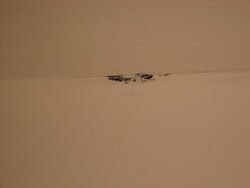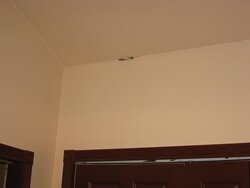Anyone have any experience in dealing with mold indoors and remediating not only the mold, but also the cause? I've got a funky smell in the house and just the other day I looked up and noticed this huge black smear coming through the master bedroom where the ceiling meets the wall. Its mold and I have to kill it. Years ago before we painted the rom I had a spot there too, I cut it out, couldn't find anything else and chalked it up to mouisture inside the sheel from construction...cleaned it all up and went on my way...well its back now so obviously I've missed the cause so I need to fix it.
Some background info. House is pretty new. Log cabin kit assembled weathertight by a certified log cabin guy. Project was completed in Dec 2002 and we moved in in January 2003. The mold is right next to the master (upstairs) bath (I'll get some photos tonight). I strongly suspect at least part of my problem is inadequate ventilation. The bathroom vent fans are plumbed outside, but there is no actual vent exhaust installed...rather they both (first and second floor bathrooms stacked on top of each other) are run out to the soffit vents under the eaves of the roof. Cool way to hide them and not clutter up the exterior of my house, but I suspect that each one is a round 4" tube that is just pushed up against what is effectively a 4"x1.5" rectangular opening, likely resulting in about half of the vent pipe being covered up and probably venting some of the air back into my house...effectively pluming moist air indirectly into the living area and whats probably worse, directly into the space between the floors and inside the roof rafters. I surmise this is so because I have these charming little dust bunnies on the wall near the ceiling in the first floor bath, they're about 4-6" down the wall from the ceiling and more or less directly below where the exhaust vent goes out to the soffit...when the vent fan is runing I can see the dust bunnies moving in the breeze and I cna feel a steady stream of air coming out of the area where the ceiling meets the wall...that stream of air goes away when I turn off the vent fan. The second floor exhaust is setup in an identical manner, so logically if one is creating backpressure into the house, the other might be too...but the celing is better sealed in the upstairs bath (its all sheet rock and downstairs the wall is log so it needs trip to seal it up properly)...so if that secodn floor exhaust can't push moist air back into the bathroom itself, its probably going into the rafter area and dumping moisture into that area...thus causing the mold.
So I need to get opinions on how to best track down the root problem and fix it and what to do with the mold I've got. Wash it with bleach or something? Some other anti-mold product? Cut out the infected material and patch the holes?
I want to do it right and fix the problem, but this is strictly DIY, I simply do not have the resources to hire a professional.
Some background info. House is pretty new. Log cabin kit assembled weathertight by a certified log cabin guy. Project was completed in Dec 2002 and we moved in in January 2003. The mold is right next to the master (upstairs) bath (I'll get some photos tonight). I strongly suspect at least part of my problem is inadequate ventilation. The bathroom vent fans are plumbed outside, but there is no actual vent exhaust installed...rather they both (first and second floor bathrooms stacked on top of each other) are run out to the soffit vents under the eaves of the roof. Cool way to hide them and not clutter up the exterior of my house, but I suspect that each one is a round 4" tube that is just pushed up against what is effectively a 4"x1.5" rectangular opening, likely resulting in about half of the vent pipe being covered up and probably venting some of the air back into my house...effectively pluming moist air indirectly into the living area and whats probably worse, directly into the space between the floors and inside the roof rafters. I surmise this is so because I have these charming little dust bunnies on the wall near the ceiling in the first floor bath, they're about 4-6" down the wall from the ceiling and more or less directly below where the exhaust vent goes out to the soffit...when the vent fan is runing I can see the dust bunnies moving in the breeze and I cna feel a steady stream of air coming out of the area where the ceiling meets the wall...that stream of air goes away when I turn off the vent fan. The second floor exhaust is setup in an identical manner, so logically if one is creating backpressure into the house, the other might be too...but the celing is better sealed in the upstairs bath (its all sheet rock and downstairs the wall is log so it needs trip to seal it up properly)...so if that secodn floor exhaust can't push moist air back into the bathroom itself, its probably going into the rafter area and dumping moisture into that area...thus causing the mold.
So I need to get opinions on how to best track down the root problem and fix it and what to do with the mold I've got. Wash it with bleach or something? Some other anti-mold product? Cut out the infected material and patch the holes?
I want to do it right and fix the problem, but this is strictly DIY, I simply do not have the resources to hire a professional.



